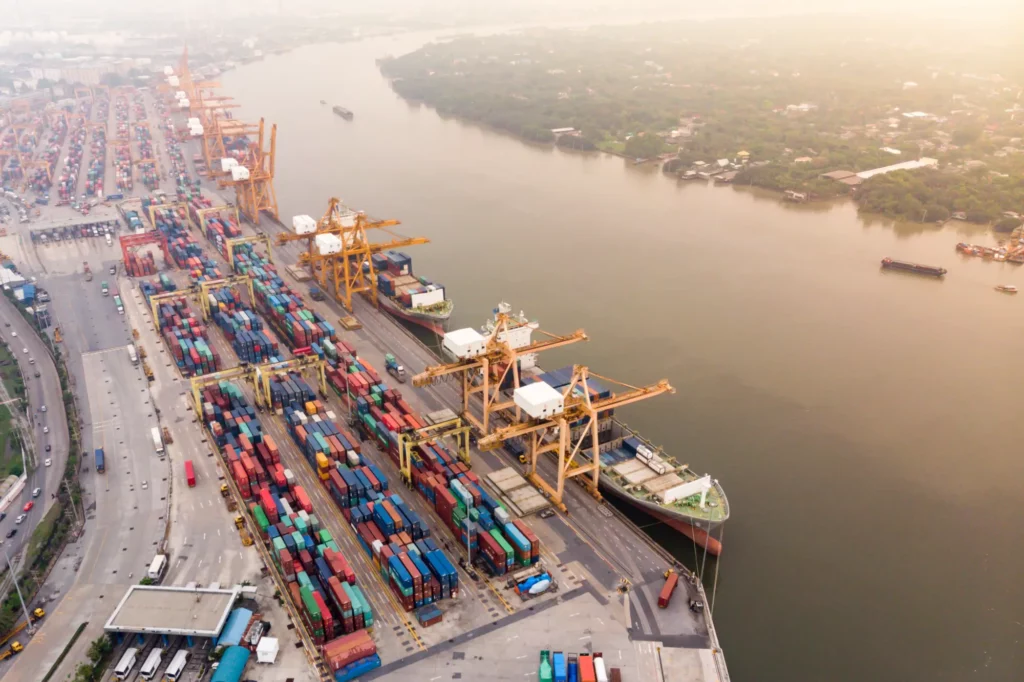The logistics industry is characterized by its continuous growth and development. Changes in trade policies, geopolitical hurricanes, advancements in technology, and varying consumer preferences are all shaping the future of freight forwarding. Shippers must be ready to adjust their strategies to meet new demands and overcome challenges to avoid going overboard in this game. This is especially important for those entering the complex and highly competitive American market, where efficiency, reliability, and the ability to anticipate and respond to changes can set a company apart from the competition.
Staying in tune with the latest trends is especially crucial for international shippers looking to make their mark in the American market. As global trade dynamics evolve, adapting to new technologies, regulatory changes, and shifts in consumer demand can become that winning difference all businesses are looking for.
2024 Is a Year of Challenges but Also New Opportunities

The year 2024 should become the year of significant transformation in the logistics sector, influenced by a complex mix of geopolitical tensions, environmental considerations, and rising customer expectations. These will put additional pressure on shippers, making them find unique solutions that align with the evolving industry trends and challenges.
Geopolitical Situation
The current global geopolitical situation presents a series of challenges that significantly impact the logistics and freight forwarding industry. Wars in Ukraine and the Middle East and other global destabilization trends profoundly affect international supply chains and commodity prices. They have already disrupted traditional trade routes, increasing transportation costs and delays. In turn, this contributes to global economic uncertainty, influencing fuel prices and availability, which are critical factors in shipping costs and logistics planning.
In the United States, rising inflation is another critical concern. As inflation erodes purchasing power, consumers may focus on acquiring goods, leading to increased demand. This surge has been evident over the past year, straining inventories and pushing companies to expand their search for new suppliers. The resultant demand spike offers freight forwarders and international shippers a unique opportunity to fill the gap. With companies diversifying their supplier base to mitigate risks and ensure supply chain resilience, 2024 emerges as an opportune moment for new entrants in the US market.
Those who can efficiently manage these complexities stand to gain significantly, as the demand for diversified supply chains opens new avenues for business. International freight forwarders can benefit from this situation by offering innovative solutions to address these challenges and secure a foothold in the competitive American market.
Climate Changes
As the world grapples with the escalating impacts of climate change, the logistics sector is facing new challenges. The increasing frequency of natural disasters, such as hurricanes and droughts, disrupts supply chains and causes governments worldwide to implement stricter regulations on carbon emissions. These measures are designed to mitigate the environmental impact of shipping and logistics activities but come with new implications for the industry.
The introduction of carbon footprint restrictions leads to a significant transformation in how logistics operations are conducted. It requires more sustainable practices, potentially increasing operational costs in the short term. Initially, these added expenses may be absorbed by carriers but could eventually be passed on to customers through higher shipping rates.
While challenging, the push towards sustainability also presents a unique opportunity for the logistics industry. It stimulates the development of cutting-edge technologies and encourages freight forwarders and carriers to optimize their logistics services. Innovations such as electric vehicles, alternative fuels, and more efficient routing algorithms are just a few examples of how the industry can adapt to meet these environmental challenges. These examples show that logistics providers can reduce their environmental footprint while achieving greater efficiencies and cost savings in the long run.
Rising Customer Demands and Expectations
The balance between supply and demand is a crucial factor that logistics providers must consider. Recent forecasts by the International Shipping Association indicate a modest increase in container volume worldwide, with projections not exceeding 4% in the coming year. In contrast, the global ocean fleet is expected to see an 8% growth. This discrepancy points towards a potential oversupply in shipping capacity, leading to heightened competition among freight forwarders.
In response to this competitive pressure, freight forwarders should elevate their service offerings. First of all, this involves improving the efficiency and reliability of their services and incorporating new value-added features that can distinguish them in a crowded market. Customers today expect comprehensive logistics solutions that can offer real-time tracking, enhanced safety measures, and flexible delivery options.
Logistics providers are now focusing on creating tailored experiences that can meet the specific needs of their customers, from customized shipping schedules to specialized handling and storage solutions. This heightened focus on customer satisfaction is necessary for survival and growth in the ever-changing logistics industry.
Thirst for Digitalization and Innovative Technologies
As we enter 2024, the push toward digitalization and automation continues to play a central role in how logistics providers meet and exceed customer expectations. The demand for higher security, transparency, and flexibility in shipping processes stimulates freight forwarders to embrace new digital solutions and enhance the automation of their services. This shift towards digitalization is the response to the evolving needs of customers who value immediate access to information and seamless service interactions.
Implementing digital services requires a considerable upfront investment in technology and training. However, the payoff comes in the form of stronger customer loyalty and an expanded client base. Digital tools like real-time tracking systems, automated customer service platforms, and sophisticated data analytics offer customers unprecedented visibility and control over their shipments. This level of service improves the customer experience and streamlines operations, reducing costs and increasing efficiency for logistics providers.
Adopting innovative technologies such as blockchain for secure transactions and the Internet of Things (IoT) for enhanced supply chain visibility represents the future of freight forwarding. These technologies offer potential solutions to long-standing challenges in the logistics industry, providing opportunities for companies to differentiate themselves in a competitive market. Ultimately, the investment in digitalization and innovative technologies translates into tangible financial benefits, enabling logistics providers to offer superior services that meet the modern demands of their customers.
Other Trends
The logistics industry is also witnessing several other transformative trends. For example, the rise of e-commerce continues to influence logistics, driving the need for faster, more reliable delivery services to meet consumer expectations for quick turnaround times.
Collaboration and partnership are also emerging as key strategies, with companies joining forces to enhance their service offerings and extend their market reach. Such collaboration allows for shared innovation and resource optimization, making logistics more efficient and cost-effective.
Last but not least, the emphasis on resilience and adaptability has never been higher. With the ever-present threat of disruptions from global events, logistics providers are focusing on building more flexible and responsive supply chains. This involves diversifying suppliers, investing in contingency planning, and leveraging technology to adapt to changes swiftly.
Main Points:
2024 is shaped by various significant trends, each with challenges but also opportunities for international shippers. The geopolitical climate and climate change influence global supply chains and operational costs, urging companies to adapt to new regulations and environmental concerns. Meanwhile, evolving customer demands for transparency, speed, and sustainability are driving the need for service enhancement and differentiation in the market.
Digitalization and innovative technologies stand out as critical enablers, allowing shippers to meet these demands through improved security, efficiency, and flexibility, while the growing emphasis on sustainability, e-commerce adaptations, collaborative partnerships, and supply chain resilience are further defining the logistics landscape.
For international shippers aiming to enter or expand their presence in the American market, the time is ripe to leverage these trends. By embracing digitalization, focusing on sustainability, and responding to the dynamic needs of customers, shippers can position themselves for success. Collaboration with a trusted logistics partner like US Inbound is also not less important. It can offer valuable insights, access to advanced technologies, and a deep understanding of the American logistics sector, creating a driving force for your business growth.



